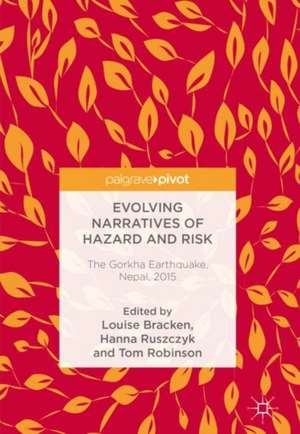Evolving Narratives of Hazard and Risk: The Gorkha Earthquake, Nepal, 2015
Editat de Louise Bracken, Hanna A. Ruszczyk, Tom Robinsonen Limba Engleză Hardback – 2 mar 2018
Evolving Narratives of Hazard and Risk explores the event of the earthquake, its consequences and its impacts, to provide a holistic and multi-perspective understanding of this special hazard and its significant ramifications for social, political, economic and cultural aspects of life in Nepal. The book highlights how these multiple perspectives are needed to inform each other in order to develop and shape new ways of thinking and interacting with environmental hazards.
This collection of works will be of interest to students and academics of Environment Studies, Human Geography and Environmental Policy, and will be of particular relevance to those involved in risk research and managing risk and hazard events.
| Toate formatele și edițiile | Preț | Express |
|---|---|---|
| Paperback (1) | 381.59 lei 6-8 săpt. | |
| Springer International Publishing – 26 ian 2019 | 381.59 lei 6-8 săpt. | |
| Hardback (1) | 387.75 lei 6-8 săpt. | |
| Springer International Publishing – 2 mar 2018 | 387.75 lei 6-8 săpt. |
Preț: 387.75 lei
Nou
Puncte Express: 582
Preț estimativ în valută:
74.20€ • 77.63$ • 61.63£
74.20€ • 77.63$ • 61.63£
Carte tipărită la comandă
Livrare economică 02-16 aprilie
Preluare comenzi: 021 569.72.76
Specificații
ISBN-13: 9783319652108
ISBN-10: 3319652109
Pagini: 192
Ilustrații: XXI, 192 p.
Dimensiuni: 148 x 210 x 20 mm
Greutate: 0.41 kg
Ediția:1st ed. 2018
Editura: Springer International Publishing
Colecția Palgrave Macmillan
Locul publicării:Cham, Switzerland
ISBN-10: 3319652109
Pagini: 192
Ilustrații: XXI, 192 p.
Dimensiuni: 148 x 210 x 20 mm
Greutate: 0.41 kg
Ediția:1st ed. 2018
Editura: Springer International Publishing
Colecția Palgrave Macmillan
Locul publicării:Cham, Switzerland
Cuprins
Part I: Earthquake Preparedness and Response .- 1. Introduction to the Gorkha earthquake; Hanna Ruszczyk and Tom Robinson .- 2. Earthquake Risk Reduction Efforts in Nepal: NSET's Experience; Amod M. Dixit et atl. .- 3. The First 100 Hours: Emergency Response to the Gorkha Earthquake; Gopi Basyal .- 4. Health and the Nepal Earthquake: Ways Forward; Ramjee Bhandari, Chandika Shrestha and Shiva Raj Mishra .- 5. The Science of Earthquake Forecasting: What's Next for Nepal and the Himalayan Region?; Sanchita Neupane .- 6. Disaster Games and the Role of Science for Informing High-Level Emergency Response Planning for Nepal; Tom Robinson .- Part II: Disciplinary Perspectives .- 7. Communities in the Aftermath of Nepal's Earthquake; Ben Campbell .- 8. The Earthquake and Ideas Lying Around; Hanna Ruszczyk .- 9. Green Social Work and the Uptake by the Nepal School of Social Work: Building Resilience in Disaster Stricken Communities; Lena Dominelli .- 10. Looking Down Not Up: Protecting thePost-Disaster Subsurface Heritage of the Kathmandu Valley's UNESCO World Heritage Site; Robin Coningham et al. .- 11.Looking and Moving Forward; Tom Robinson, Hanna Ruszczyk, and Louise Bracken.
Notă biografică
Louise Bracken is Executive Director of the Institute of Hazard, Risk and Resilience and the Wilson Chair in Hazard and Risk Research at Durham University, UK.
Hanna Ruszczyk is a Post Doctoral Research Associate in the Institute of Hazard, Risk and Resilience at Durham University, UK.
Tom Robinson is an Addison Wheeler Fellow in the Department of Geography at Durham University, UK.
Hanna Ruszczyk is a Post Doctoral Research Associate in the Institute of Hazard, Risk and Resilience at Durham University, UK.
Tom Robinson is an Addison Wheeler Fellow in the Department of Geography at Durham University, UK.
Textul de pe ultima copertă
This book presents a range of academic research and personal reflections on the Gorkha earthquake that struck Nepal in 2015. For the first time, perspectives from geography, disaster risk reduction, cultural heritage protection, archaeology, anthropology, social work, health and emergency response are discussed in a single volume. Contributions are included from practitioners and researchers from Nepal and Durham University in the UK, many of whom were in Nepal at the time of the earthquake.
Evolving Narratives of Hazard and Risk explores the event of the earthquake, its consequences and its impacts, to provide a holistic and multi-perspective understanding of this special hazard and its significant ramifications for social, political, economic and cultural aspects of life in Nepal. The book highlights how these multiple perspectives are needed to inform each other in order to develop and shape new ways of thinking and interacting with environmental hazards.
This collection of works will be of interest to students and academics of Environment Studies, Human Geography and Environmental Policy, and will be of particular relevance to those involved in risk research and managing risk and hazard events.
Evolving Narratives of Hazard and Risk explores the event of the earthquake, its consequences and its impacts, to provide a holistic and multi-perspective understanding of this special hazard and its significant ramifications for social, political, economic and cultural aspects of life in Nepal. The book highlights how these multiple perspectives are needed to inform each other in order to develop and shape new ways of thinking and interacting with environmental hazards.
This collection of works will be of interest to students and academics of Environment Studies, Human Geography and Environmental Policy, and will be of particular relevance to those involved in risk research and managing risk and hazard events.
Caracteristici
Draws from multiple perspective of the Gorkha earthquake in 2015 to inform Disaster Risk Reduction research and practice Provides reflections and interviews from people caught up in the Gorkha 2015 earthquake and involved in managing emergency response and immediate recovery efforts Includes an investigation on earthquake damage and inappropriate post-disaster responses as well as noting the limited protection offered to monuments and their subsurface heritage
